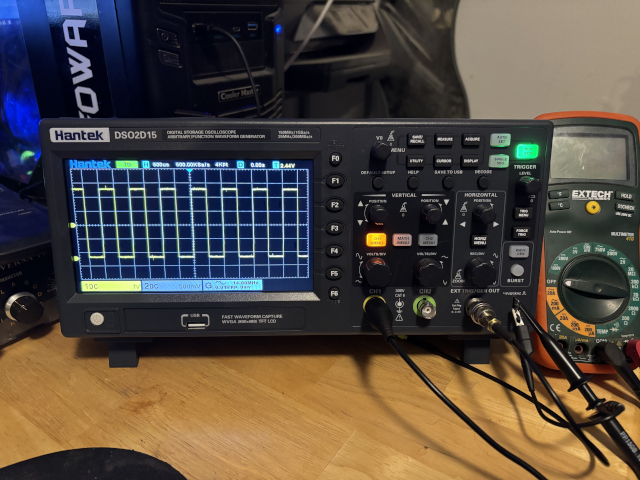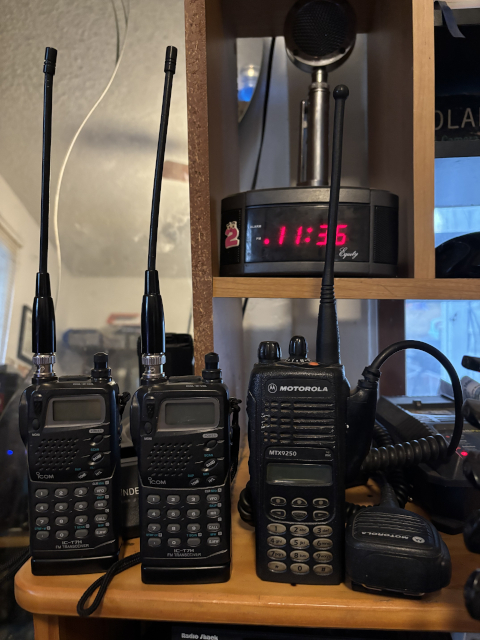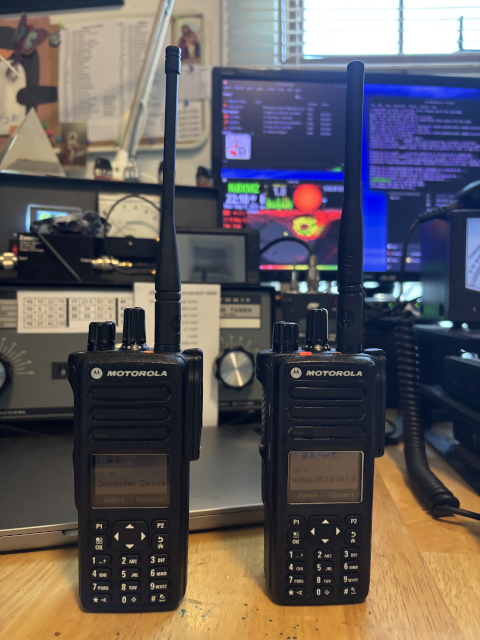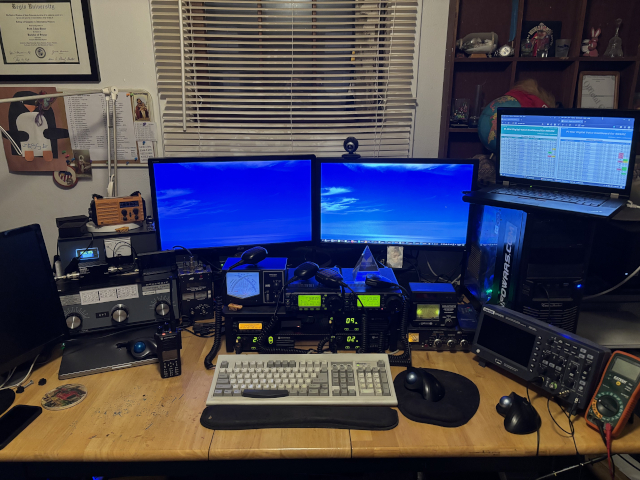
A view of the home office. There are a few computers and Raspberry Pis, all
doing their thing. All machines run Kubuntu Linux except for the Macbook I use for
work.
This computer and two others in the house have virtual machines that do protein folding simulations for
Standford University's Folding@Home distributed computing project.
The project studies how proteins misfold and how that leads to diseases like Alzheimer's and cancer.
This is the main PC for the house. It's a file server, VM host, and daily driver. The computer, HF radios,
tuners, and power supplies are all connected via 1/2" braid to a 1/2" copper pipe which is soldered to a 1 ga.
cable leading to a ground rod outside the window. It's amazing what a good ground can do!
The IC-706Mk2G is my HF rig while the IC-706Mk2 is dedicated to 6 meters and 2 meters digital modes. I recently put
together a 5-element yagi for 6 that will soon go on the roof. I recently bought a tower as well but I plan
to save it for when I move in about a year.
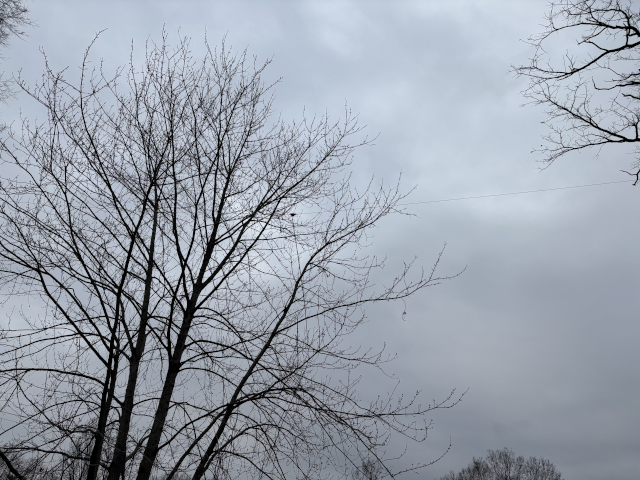
At left is part of my G5RV Jr. antenna which I use on 10 - 40m. Although it's
not very high up, the performance is very good. I have it hanging
between two trees and used a slingshot and rope to get it there.
My method was to use a large nut for a weight, tied to a strong string. Large fishing
weights work just as well. It took a lot of
tries but I finally got it over a branch. I then had to climb up a ladder with my skyrake
to grab the nut hanging out of reach. I tied the string to a strong rope and pulled
it all the way until I could cut off the string and I had a rope hanging over the branch
about 20 feet up. I repeated the process on the other end of the antenna, attached the
wires to the ropes, and started pulling the ropes. Next thing you know, it's up in the clear. I weighted each end down with a gallon of water. This allows for the
rope to have some give and move up or down slightly, as in a storm. That gives it strength and flexibility.
I like to use clothesline rope from Ace Hardware. It's strong, fairly smooth (for going over
branches) and stands up under harsh weather.
There were some times I got a rope stuck in a
tree or needed to grab the weight on the rope with something longer than I can reach so I
duct-taped this rake to the end of a 10' section of conduit. On a ladder, I was able to
clear most snags. When larger branches got in the way, I cut them down with a saw. I call this
contraption the "skyrake" (pictured below with my dog Rocky).
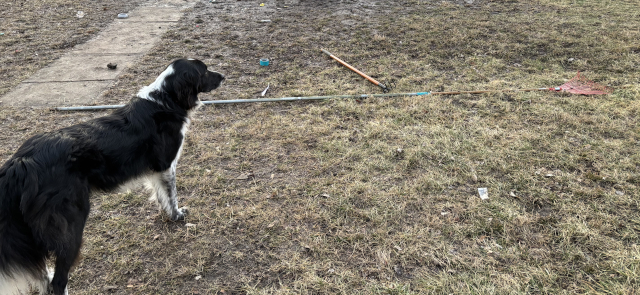
Below is my small antenna farm on the roof. To the left is a dual-band
Comet GP-6 for 2m/70cm. It's 10 ft. long but very lightweight, sitting atop a 10 ft. mast.
It has 6.6 dBi gain on VHF and 9 dBi on UHF. To the far right is a Comet
KP-20 for 33cm, 8 ft. long, a 12-element colinear, 9.2 dBi gain. It sits atop a 20 ft. mast. The j-pole in the middle is
no longer there. I replaced it with a slim jim made from ladder line and it hangs in a tree in the front yard. If you look
closely, you'll also see my 6-meter dipole strung between a tree and the roof. I'm in the process of replacing that with
a 5-element yagi that is ready to go on the roof. I had back surgery recently so I'll mount it once I'm able to climb again.
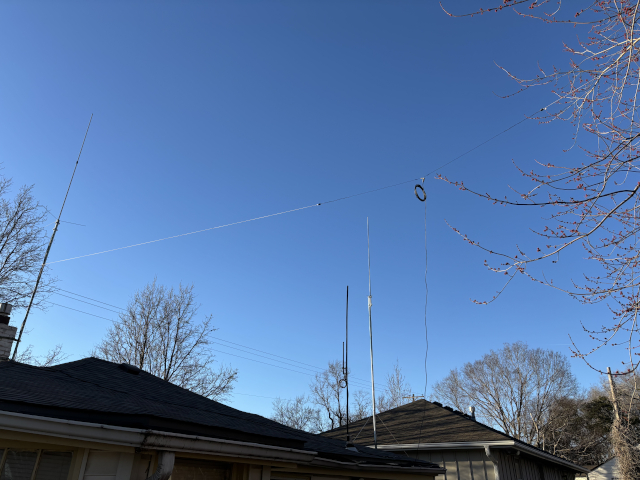
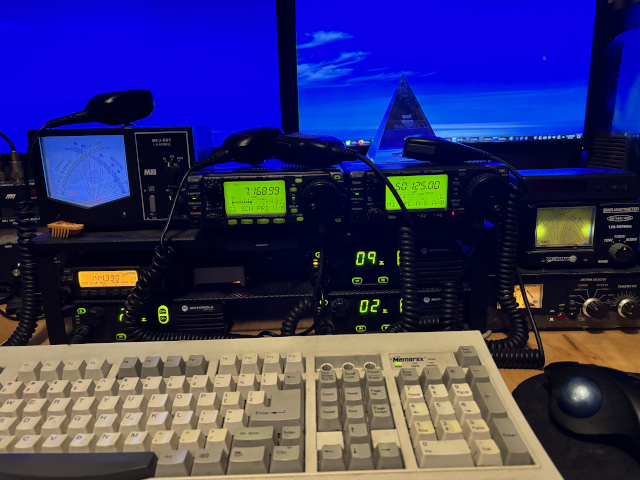
A close-up of the radios. Icom IC-706 MKIIG for HF, IC-706 MKII dedicated to 6 meters,
an Icom IC-207 for that serves as an APRS digipeater/gateway along with the Raspberry Pi right next
it. There are two Mototola XPR 4350s for V/UHF analog
and DMR, and a Motorola XPR 4380 for 33cm.
There are a few 900 MHz repeaters in town but almost no one on them.
I've made it a personal crusade to get more people on 900. It's a fun band! It's
very much like 70cm in terms of propagation. You won't find ham gear for 900 except for
some old Icoms and Alincos but good luck finding them. Most of us use commercial radios
made by Motorola and Kenwood. Some of them, like the old Spectras, require hardware mods
in addition to software hacking. Thankfully, no hacking is required with the right versions
of the MTX-4350 2m/70cm radios, the Mototrbo CPS is happy to take amateur frequencies. The
900 MHz verion, the XPR 4380, requires in-memory hex-editing (aka "bit-banging") to set
amateur frequencies.
I knew there were some HTs around here somewhere. Two Icom T7H
dual band units (because they're the best and aren't made anymore) and a Motorola MTX 9250
for 900 MHz. These radios are durable, can really take a beating. I miss my Kenwood
D-72A with all its bells and whistles but the case on it breaks too easily so I sold it.
My newest radios are the Motorola XPR 7550s for 70cm and 2m (below). I got a great deal on the UHF unit at a local
hamfest and I found the VHF unit on eBay. These are now my favorite HTs. I found a
Raspberry Pi-based hotspot at the hamfest as well. I quickly decided that the simplex nature of the
hotspot was unacceptable so I bought a duplex model and now they both split the traffic between
all the talkgroups I listen to. Then I bought another one! While hotpsots may not be very useful in a disaster situation, they sure are fun
to play with and I get a range of about a quarter mile with 10 mw! I've been having a lot of fun
with DMR lately and all of my /\/\ radios do DMR except for the 900 MHz HT.
Behind the Motorola HTs is the MFJ-259B antenna/feedline analyzer. I never set up a
new antenna without it!
It spends most of its time right here for when I need to adjust antenna tuner settings. Behind that
you can almost make out the "Hamclock" software I'm running on the computer. That sucker is one
of the most useful tools in my belt. It shows propagation conditions with predictions, current space weather stats,
worldwide latitude/longitude lookup, all kinds of cool gadgets.
Below is one of the newest toys I've added to my collection, the TinySA Ultra+.
It's a spectrum analyzer that covers DC to about 6 GHz. When I first became a ham, the price of a
spectrum analyzer was way more than I could afford. Thank God for advances in
technology.
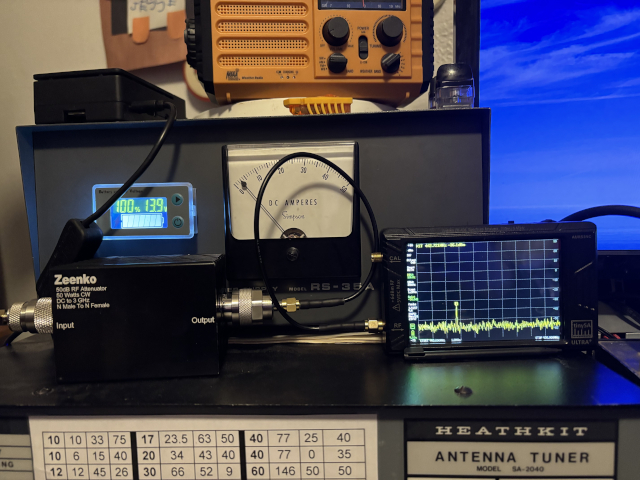
No hamshack is complete without an oscilloscope. I have a couple of old Tektronix scopes in the shed. One of them
barely works. This badboy puts them both to shame and it was only around $200.
